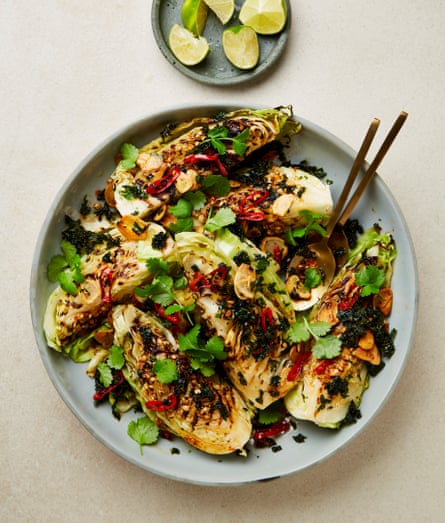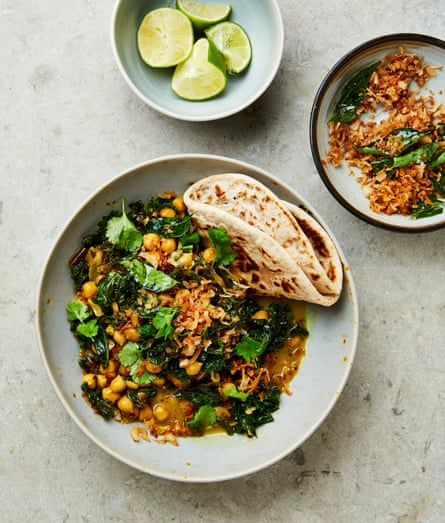September’s a month that always feels a bit like a new term, whether or not you’re packing the kids back to school. Memories of school carry, for many, the not-always-sweet smell of overcooked cabbage, but that can be easily set right. Cabbage is just one member of the brassica family whose leaves, flowers, stems and roots can all be eaten – think broccoli, brussels sprouts, cauliflower, kale, hispi … The solution to that familiar school corridor smell is not to overcook it and to balance it with something creamy (such as yoghurt) or sweet (such as coconut). So there we go: the first lesson of the new term and, I hope, some delicious recipes to set everyone on their September way.
Roast cauliflower with yoghurt and spicy red pepper sauce (pictured top)
Red pepper paste is essential to Turkish cuisine, and regularly puts in an appearance in dolmas, bulgur dishes and all sorts of dips. You can buy it in most Middle Eastern shops or online, but don’t worry if you can’t find any: use tomato paste mixed with a little extra aleppo chilli instead.
Prep 45 min
Cook 30 min
Serves 4
1 large cauliflower (1kg), leaves and base trimmed, then cut into 8 x 4cm-thick wedges (800g net)
75ml olive oil
Salt and black pepper
1 onion, peeled, halved and cut into ½cm-thick slices
1 tbsp coriander seeds, lightly toasted and roughly crushed in a mortar
1 tsp caraway seeds, lightly toasted and roughly crushed in a mortar
1½ tsp sumac
25g mint leaves, roughly chopped, plus 1 handful extra, to serve
30g pine nuts, toasted
For the yoghurt sauce
300g Greek-style yoghurt
1 garlic clove, peeled and crushed
2 tbsp lemon juice (from 1-2 lemons)
For the red pepper sauce
70ml olive oil
2 tbsp mild Turkish pepper paste (or tomato paste)
1 tbsp aleppo chilli, plus extra to serve (or 1½ tbsp if using tomato paste)
Heat the oven to 240C (220C fan)/475F/gas 9. In a large bowl, toss the cauliflower with three tablespoons of oil and a half-teaspoon of salt, then spread out on a large oven tray lined with greaseproof paper. Roast for 22-25 minutes, until lightly charred but still with a bite. Transfer to a large bowl and leave to cool.
Meanwhile, put the remaining two tablespoons of oil in a medium saute pan on a medium heat. Once hot, add the onion and an eighth of a teaspoon of salt and cook, stirring occasionally, for 15-18 minutes, until soft and browned. Tip the onions into the cauliflower bowl and wipe clean the pan.
Put the oil for the pepper sauce in a saute pan on a medium-high heat and, once hot, add the pepper paste and aleppo chilli and cook, stirring, for 30 seconds. Take off the heat, stir in a pinch of salt and a good grind of pepper, and transfer to a medium heatproof bowl.
For the yoghurt sauce, mix the yoghurt, garlic, a tablespoon of lemon juice, a quarter-teaspoon of salt and a good grind of black pepper in a medium bowl and set aside.
Stir the coriander, caraway, sumac, mint, half the pine nuts, the remaining tablespoon of lemon juice and a good grind of pepper into the cauliflower bowl.
To serve, spread the yoghurt sauce over a shallow platter and arrange the cauliflower mixture on top. Spoon over half the red pepper sauce, then top with the extra mint leaves and the remaining pine nuts. Serve with the rest of the pepper sauce in a bowl alongside.
Grilled hispi cabbage with coriander, garlic, chilli and lime oil

This sweet cabbage is deliciously complemented by the hot and fragrant chilli and lime oil: make sure you serve it with plenty of crusty bread to mop everything up with. Serve as a vegetarian main course or as a side to grilled fish or tofu.
Prep 10 min
Cook 15 min
Serves 2 as a main, 4 as a side
2 hispi cabbages (800g), cut lengthways into quarters, core and all
120ml olive oil
Salt and pepper
50g fresh coriander, 40g finely chopped, 10g leaves left whole
7 garlic cloves, peeled and thinly sliced
1 large red chilli, thinly sliced on an angle
1½ tsp coriander seeds, roughly crushed in a mortar
1 tsp sweet paprika
2 limes, 1 juiced, to get 1 tbsp, the other cut into 4 wedges
Put a griddle pan on a high heat. While it’s getting hot, put the cabbage on a tray, rub it all over in two tablespoons of oil and season with a half-teaspoon of salt and a good grind of pepper, making sure the oil and salt gets in between the layers.
Grill four cabbage quarters, turning as necessary, for about four to five minutes, so they’re softened and nicely charred on all three sides. Transfer to a platter with a rim and repeat with the four remaining cabbage quarters.
Put the remaining 90ml oil in a small saute pan on a medium-high heat and, once hot, add the chopped coriander and fry for three minutes, until deeply green. Add the garlic and chilli, turn down the heat to medium and fry for another five minutes, or until the garlic and chilli are crisp and lightly golden. Off the heat, stir in the coriander seeds, paprika and a quarter-teaspoon of salt, then add the lime juice.
Spoon the oil and solids all over the grilled hispi, top with the coriander leaves and serve warm with the lime wedges on the side.
Kale and chickpeas with curry leaves and crisp coconut

Double up on the crisp coconut, if you like – it’s good sprinkled over salads or noodle dishes. I’ve used jarred chickpeas, because they’re softer and therefore easier to eat, but tinned or cooked from dried will also work here. Serve with rice or flatbreads to soak up all the flavourful juices.
Prep 20 min
Cook 40 min
Serves 4
60g virgin coconut oil
70g freshly grated coconut
12 fresh curry leaves (ie, from 1-2 stems)
⅛ tsp caster sugar
Salt and pepper
1 large onion, peeled, halved and thinly sliced (220g net)
3 garlic cloves, peeled and crushed
2 dried hot red chillies, roughly chopped
30g bunch coriander, leaves picked and stalks finely chopped
1½ tsp black mustard seeds
1 tsp ground turmeric
300g jarred chickpeas (drained weight, so from a 450g jar)
400g kale, stems removed and leaves roughly torn (250g net)
1 x 400ml tin full-fat coconut milk (70%)
2 limes – 1 juiced, to get 1 tbsp, the other cut into 4 wedges
Put the coconut oil in a medium saute pan for which you have a lid, and set it over a medium-high heat. Once hot, add the fresh coconut and the curry leaves, and fry, stirring occasionally, for about five minutes, until golden. Drain through a small sieve set over a bowl to collect the oil, then transfer the solids to a second small bowl and, while they’re still warm, stir in the sugar and an eighth of a teaspoon of salt.
Return the drained coconut oil to the pan and turn on the heat to medium-high. Once hot, add the onions, garlic, dried chillies and coriander stalks and cook, stirring occasionally, for about 10 minutes, until the onions are lightly browned. Stir in the mustard seeds and turmeric, cook for 30 seconds, until fragrant, then add the chickpeas and fry, stirring occasionally, for five minutes, until they take on some colour. Add the shredded kale in about three batches, stirring to wilt each batch for 90 or so seconds before adding the next. Pour in the coconut milk, add three-quarters of a teaspoon of salt and a good grind of pepper, cover and leave to cook for 10 minutes, until the kale is nicely tender. Take off the heat, and stir in three-quarters of the picked coriander leaves and all the lime juice.
Transfer the kale mix to a large, shallow bowl and top with the remaining coriander leaves and some of the crisp coconut mixture. Serve with the remaining coconut mix and lime wedges alongside.

Comments (…)
Sign in or create your Guardian account to join the discussion